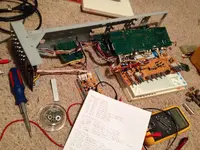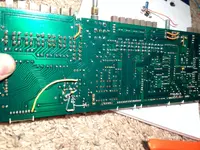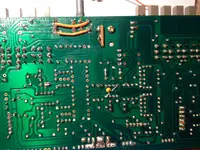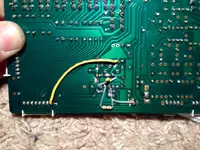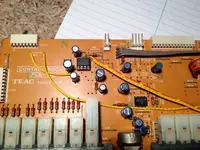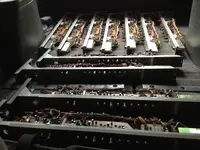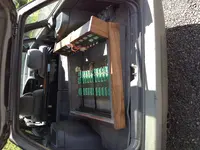So I got all of the opamp functions identified in the master module, and identified a few that I want to replace with some different parts.
The headphone amp section periodically still makes some random sputtering noises for awhile until the console has been powered for awhile. The amp circuit is really simple and is the same as found in a number of other Teac units and is based on the 386 chip. The opamp is the only active device in the circuit and I suspect the source of the noise might be there so I'm replacing those with new TI branded 386 parts.
The overload LED comparators for the stereo buss are mismatched...one is a 339 and the other is a 2903. These *are* equivalent parts, but I think they should match. Hair-splitting? You betcha. But I've got it all pulled apart so making it "right" now makes sense. I'm putting new TI 2903 parts in there.
The output drivers on the balance amp boards for the balanced stereo output are 072s. I think 072s are a fine part. They've been *widely* used *everywhere* and *continue* to be used even today. There are even examples of "holy grail" equipment out there based around the 072. But the 2134 is an easy and popular and reliable drop-in substitute for good reason, I have them on-hand, and this is a critical amp stage, so I'm putting those in there.
The interstage stereo buss drivers are 5532s. All good there as far as I'm concerned, but what's on the boards I'm not even sure of the brand. They look like very early parts and they would be at this vintage. So I'm swapping in new TI branded 5532 parts. Hey...I'm in there already right?
The control room output driver is a 4556. I'm doing the same thing there as I'm doing on the input/output modules with the input buffer/direct out driver and putting in a 5532 there. The control room buss is a critical buss for mixing. Along those lines I'm also replacing the 082 control room interstage driver with a 2134 for the same reason.
There is quad logic switching chip on one of the boards that has corrosion on it's legs from the historical rodent pee. Putting a new TI part there too.
Back to the control room buss for a moment...here's where things get interesting...there is a super-duper prototypey lookin kludge on the backside of the control room interstage driver...it's always freaked me out. So I now know all that is is the driver for the MONO circuit on the control room buss...it's a simple summing amp circuit. But it's crazy looking, and clearly a bizarre afterthought. The control room PCB is the same as the studio PCB in the master module...they should have made a different PCB just for the control room board but this is prototype-land and they didn't, and as a result kludged in this mono summing amp. There is a vacant DIP-8 site on the control room PCB that is populated on the studio PCB. I'm going to modify traces and locate the summing amp there rather than it hanging in space like it was.
Here is the cluster mess that is the kludged mono summing amp:
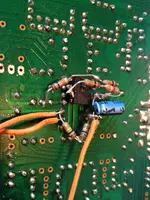
At the tip of my thumb there is the vacant DIP-8 site to where I want to relocate the summing amp. This location on the studio PCB is where the summing amp for the two ECHO RETURN inputs lives...dual opamp, one channel per return channel, so that's why the site is not populated on the control room PCB:
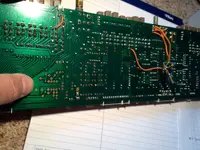
Naturally the work will require cutting traces and jumpering connections, adding filter caps etc., but I reverse-engineered a schematic for how the mono summing amp is connected to the control room buss interstage driver mentioned above, and though in the end it won't look as nice as factory, it'll be a far-sight better than the krazy kluster pictured above and ultimately a more reliable installation. And there is already a fair amount of cut and jumpered traces throughout this console; part of it's character.
The mono summing amp schematic sketch...I may re-draw at some point as this was the first draft "sketch-as-you-go" version as I was working through the circuit:
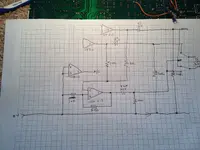
Here's the collection of parts I've pulled from the master module:

I've done all I can at this point until parts arrive, but with a couple of exceptions I'm using good quality machine-pin type sockets for any opamps that are being changed out, so I've got those installed ready for the replacement opamps to be plugged in when they arrive.
There are some other repairs I'm doing that I think I saw in the past but ignored not feeling confident to be messing with things...a couple wire junctions with electrical tape as insulation (going to replace with heat-shrink)...

And a number of components upon which I see corrosion from historical rodent pee. I want this thing to be reliable, so I'm replacing anything that looks like these parts with the blue-green death on them:
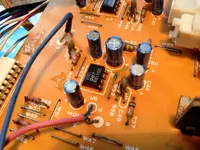
So that's the update. Stay tuned. I'll complete these modifications/repairs on the master module and then get back to those select modifications on the input/output modules and then finally complete the comprehensive testing that got interrupted when the oscillation issue was discovered.

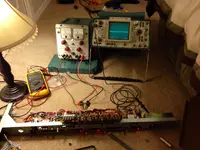

 I'm happy for you man.
I'm happy for you man.  ----->
-----> 